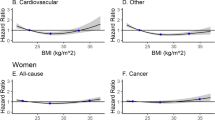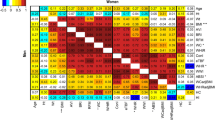Abstract
OBJECTIVE: To investigate whether waist and hip circumferences, in addition to body mass index (BMI), are related to all-cause mortality. We studied these associations and tested the usefulness of the waist-to-hip ratio for mortality prediction.
DESIGN: A Danish prospective cohort study with data collected between 1993 and 1997.
SUBJECTS: A total of 27 179 men and 29 875 women born in Denmark and aged 50–64 years were followed for a median of 6.8 years.
MEASUREMENTS: BMI, waist and hip circumferences at baseline.
RESULTS: The associations between hip circumference and all-cause mortality were inverse for both men and women, but only after adjustment for waist circumference, or BMI, or both. The mortality rate ratios of mutually adjusted waist and hip circumferences were 0.63 (95% CI: 0.56, 0.71), and 0.70 (95% CI: 0.63, 0.79) times higher per 10% larger hip circumference in men and women, respectively, and 1.45 (95% CI: 1.34, 1.57) and 1.22 (95% CI: 1.14, 1.31) times higher per 10% larger waist circumference. The adequacy of the waist-to-hip ratio as a substitute for separate measurements of waist and hip circumferences depended on which other variables the analysis was adjusted for, indicating that the waist-to-hip ratio should be used with precaution.
CONCLUSION: When mutually adjusted, waist and hip circumferences show opposite associations with all-cause mortality, probably due to different effects of adipose tissue in the abdominal and gluteofemoral regions. The waist-to-hip ratio cannot always capture these relations adequately.
This is a preview of subscription content, access via your institution
Access options
Subscribe to this journal
Receive 12 print issues and online access
$259.00 per year
only $21.58 per issue
Buy this article
- Purchase on Springer Link
- Instant access to full article PDF
Prices may be subject to local taxes which are calculated during checkout

Similar content being viewed by others
References
Lapidus L, Bengtsson C, Larsson B, Pennert K, Rybo E, Sjostrom L . Distribution of adipose tissue and risk of cardiovascular disease and death: a 12 year follow up of participants in the population study of women in Gothenburg, Sweden. BMJ 1984; 289: 1257–1261.
Larsson B, Svardsudd K, Welin L, Wilhelmsen L, Bjorntorp P, Tibblin G . Abdominal adipose tissue distribution, obesity, and risk of cardiovascular disease and death: 13 year follow up of participants in the study of men born in 1913. BMJ 1984; 288: 1401–1404.
Folsom AR, Kushi LH, Anderson KE, Mink PJ, Olson JE, Hong CP, Sellers TA, Lazovich D, Prineas RJ . Associations of general and abdominal obesity with multiple health outcomes in older women: the Iowa Women's Health Study. Arch Intern Med 2000; 160: 2117–2128.
Kalmijn S, Curb JD, Rodriguez BL, Yano K, Abbott RD . The association of body weight and anthropometry with mortality in elderly men: the Honolulu Heart Program. Int J Obes Relat Metab Disord 1999; 23: 395–402.
Lahmann PH, Lissner L, Gullberg B, Berglund G . A prospective study of adiposity and all-cause mortality: The Malmo Diet and Cancer Study. Obes Res 2002; 10: 361–369.
Baik I, Ascherio A, Rimm EB, Giovannucci E, Spiegelman D, Stampfer MJ, Willett WC . Adiposity and mortality in men. Am J Epidemiol 2000; 152: 264–271.
Folsom AR, Kaye SA, Sellers TA, Hong CP, Cerhan JR, Potter JD, Prineas RJ . Body fat distribution and 5-year risk of death in older women. JAMA 1993; 269: 483–487.
Lissner L, Bjorkelund C, Heitmann BL, Seidell JC, Bengtsson C . Larger hip circumference independently predicts health and longevity in a Swedish female cohort. Obes Res 2001; 9: 644–646.
Carey VJ, Walters EE, Colditz GA, Solomon CG, Willett WC, Rosner BA, Speizer FE, Manson JE . Body fat distribution and risk of non-insulin-dependent diabetes mellitus in women. The Nurses’ Health Study. Am J Epidemiol 1997; 145: 614–619.
Wei M, Gaskill SP, Haffner SM, Stern MP . Waist circumference as the best predictor of noninsulin dependent diabetes mellitus (NIDDM) compared to body mass index, waist/hip ratio and other anthropometric measurements in Mexican Americans—a 7-year prospective study. Obes Res 1997; 5: 16–23.
Chan JM, Rimm EB, Colditz GA, Stampfer MJ, Willett WC . Obesity, fat distribution, and weight gain as risk factors for clinical diabetes in men. Diabetes Care 1994; 17: 961–969.
Seidell JC, Perusse L, Despres JP, Bouchard C . Waist and hip circumferences have independent and opposite effects on cardiovascular disease risk factors: the Quebec Family Study. Am J Clin Nutr 2001; 74: 315–321.
Han TS, Bijnen FC, Lean ME, Seidell JC . Separate associations of waist and hip circumference with lifestyle factors. Int J Epidemiol 1998; 27: 422–430.
Molarius A, Seidell JC . Selection of anthropometric indicators for classification of abdominal fatness—a critical review. Int J Obes Relat Metab Disord 1998; 22: 719–727.
Allison DB, Paultre F, Goran MI, Poehlman ET, Heymsfield SB . Statistical considerations regarding the use of ratios to adjust data. Int J Obes Relat Metab Disord 1995; 19: 644–652.
Korn EL, Graubard BI, Midthune D . Time-to-event analysis of longitudinal follow-up of a survey: choice of the time-scale. Am J Epidemiol 1997; 145: 72–80.
Greenland S . Dose–response and trend analysis in epidemiology: alternatives to categorical analysis. Epidemiology 1995; 6: 356–365.
WHO. Obesity: preventing and managing the global epidemic, Report of a WHO consultation, WHO Technical Report Series No. 894. World Health Organization: Geneva; 2000.
Tjønneland A, Overvad OK . Diet, cancer and health—a population study and establishment of a biological bank in Denmark (in Danish). Ugeskr Laeger 2000; 162: 350–354.
Snijder MB, Dekker JM, Visser M, Yudkin JS, Stehouwer CD, Bouter LM, Heine RJ, Nijpels G, Seidell JC . Larger thigh and hip circumferences are associated with better glucose tolerance: the hoorn study. Obes Res 2003; 11: 104–111.
Seidell JC, Han TS, Feskens EJ, Lean ME . Narrow hips and broad waist circumferences independently contribute to increased risk of non-insulin-dependent diabetes mellitus. J Intern Med 1997; 242: 401–406.
Wajchenberg BL . Subcutaneous and visceral adipose tissue: their relation to the metabolic syndrome. Endocr Rev 2000; 21: 697–738.
WHO. Physical status: the use and interpretation of anthropometry, Report of a WHO expert committee, WHO Technical Report Series No. 854. World Health Organization: Geneva; 1995.
Bjorntorp P . Abdominal fat distribution and disease: an overview of epidemiological data. Ann Med 1992; 24: 15–18.
Baumgartner RN, Heymsfield SB, Roche AF . Human body composition and the epidemiology of chronic disease. Obes Res 1995; 3: 73–95.
Acknowledgements
This study was financially supported by grants from The Danish Research Councils, Ref. Nr. 9801264 and The Danish Cancer Society. We thank programmer Katja Boll for preparation of the data set and Jytte Fogh Larsen for collection of the data. The Danish National Research Foundation supports the Danish Epidemiology Science Centre.
Author information
Authors and Affiliations
Corresponding author
Rights and permissions
About this article
Cite this article
Bigaard, J., Frederiksen, K., Tjønneland, A. et al. Waist and hip circumferences and all-cause mortality: usefulness of the waist-to-hip ratio?. Int J Obes 28, 741–747 (2004). https://doi.org/10.1038/sj.ijo.0802635
Received:
Revised:
Accepted:
Published:
Issue Date:
DOI: https://doi.org/10.1038/sj.ijo.0802635
Keywords
This article is cited by
-
Adipose depot-specific effects of 16 weeks of pioglitazone on in vivo adipogenesis in women with obesity: a randomised controlled trial
Diabetologia (2021)
-
Central adiposity at diagnosis may reduce prostate cancer-specific mortality in African-Caribbean men with prostate cancer: 10-year follow-up of participants in a case–control study
Cancer Causes & Control (2020)
-
Relative abdominal adiposity is associated with chronic low back pain: a preliminary explorative study
BMC Public Health (2016)
-
What Can We Learn from Interventions That Change Fat Distribution?
Current Obesity Reports (2016)
-
Changes in body mass index, waist and hip circumferences, waist to hip ratio and risk of all-cause mortality in men
European Journal of Clinical Nutrition (2015)



